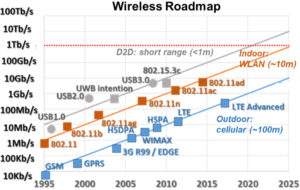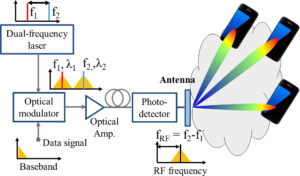Wireless data traffic increases by a factor of 100 every 10 years [1] and data rates of even Tb/s will be requested by 2025 (Fig. 1). Since Shannon’s limit is proportional to the total bandwidth (BW), a more efficient use of available spectrum will not suffice to reach the predicted data rates. The use of carriers in the sub-Terahertz (sub-THz) or submillimeter (sub-mm) wave regime (between 100 GHz and 1 THz) will be pivotal to achieve the total bandwidths required for applications like enhanced mobile broadband (eMBB), which will absorb more than 95% of the future 5G market or ultra-reliable low latency communications (URLLC). Among these applications, front- and back-hauling in beyond 5G systems, streaming of ultra-high definition multimedia and data centers are expected to push the technological developments in the sub-THz regime [2],[3]. As stated by the ITU, IEEE and ETSI roadmaps, the 275-325 GHz band will play a key role to enable ultra-large BW wireless, since it has not yet been allocated [3] and it presents atmospheric transmission windows with low attenuation levels, below 10 dB/km [3]. Indeed, a specific agenda item (1.15) at the World Radio Communication Conference 2019 has discussed the use of the 275-450 GHz frequency band for land-mobile and fixed service. The IEEE 802.15 Technical Advisory Group has also published a first standard for frequencies in the 252-325 GHz band. In Europe, ETSI’s Industry Specification Group on mm-wave transmission is focusing on frequencies from 50 GHz up to 300 GHz.

Fig. 1 Wireless standards roadmap, from the ITRS (Int. Technol. roadmap for semicond.) http://www.itrs2.net/.
To enable the use of this frequency band, adequate waveforms and front-ends with high gain and beam steering capabilities will be needed to receive/transmit efficiently in point-to-point (P2P) and point-to-multipoint (PMP) scenarios, and with a low visual impact on smart urban furniture, buildings, homes and offices. Such front-ends can be also applied in imaging systems, since wavelengths are short enough to provide high resolution with modest apertures and long enough to penetrate some materials.
In this context, although the development of advanced integrated circuits and photonic technologies is extremely important, WASSAP’s ambition is to address the following three scientific and technical (S&T) challenges on the radiofrequency side:
The first challenge arises from the enormous loss the radio link has to face. In addition to free-space propagation loss (proportional to the square of the frequency of operation), one has to compensate for the absorption of active molecules (like the strongly polar H2O) and scattering on hydro-meteors outdoors. For instance, despite the transmission window at 300 GHz, the overall attenuation adds up to 102 dB at 300 GHz for a typical indoor distance of 10 m. Compensating for the aforementioned loss implies the use of very efficient, high-gain antennas efficiently coupled to continuous-wave (CW) sources with high output power at room temperature.
The second challenge is that frequency sources and components with adequate output power are not easily available at submillimeter wavelengths. Tabletop backward wave oscillators (BWO) can produce power in the range of mW at 1THz to 100mW at ∼100GHz [4]. However, they require high voltages and have short lifetimes; they are unreliable and not easily available [4]. Quantum Cascade Laser (QCL) solid-state sources can provide tens of mW in the upper part of the THz range [4], and are more compact than BWOs. Nonetheless, the oscillation of such lasers below a few THz requires cryogenic cooling making them not suitable for real field applications [4]. To circumvent the limitations of BWOs and QCLs, sub-THz wireless links use either an electronic approach up-converting millimeter-wave signals or a photonic one down-converting from the optical regime. In this context, photonic generation of sub-THz signals by photomixing is an extremely promising route to explore. The main advantages of photomixing transmitters are that the generated sub-THz signal is tunable over a wide bandwidth and that they enable the use of reliable and cost-effective optical amplifiers (EDFA, SOA). Moreover, a seamless connection becomes feasible between sub-THz radio and 1.55-μm data flows guided in optical fibers. As shown in Fig. 2, two optical wavelengths are generated by a dual-frequency lasers and mixed on a photodetector, such as a uni-travelling carrier photodiode (UTC-PD). The electrical beat note at the output of the photodetector is equal to the frequency difference of the two optical tones. Thus, the optical tones or, at least, their frequency difference must be stabilized to comply with the sub-THz link requirement.
Finally, the third challenge consists in providing adequate waveforms for single carrier (SC) modulations in the sub-THz regime. Despite their well-known drawbacks (e.g., intersymbol interferences and high peak-to-average ratio PAPR), multi-carrier (MC) modulations are widely used in many recent wireless systems: 4G, 5G, Wifi, and video broadcasting, to name a few. Nevertheless, sub-THz transmissions call for single carrier (SC) schemes, which are much more energy-efficient at the expense of lower spectral efficiencies. Then, the challenge is to keep increasing the spectral efficiency while targeting the key requirements: long transmission ranges, high data rates and low power consumption. This challenge must be addressed while using realistic front-end data (antenna gain, carrier stability, phase noise, etc.) to define the waveform.
- “Ericsson Mobility Report”, Jun. 2019.
- T. Nagatsuma, G. Carpintero, “Recent progress and future prospect of photonics-enabled terahertz communications research,” IEICE Trans. Electron., vol E98-C, no. 12, pp. 1060–1070, Dec. 2015.
- T. Nagatsuma, G. Ducournau, and C. C. Renaud, “Advances in terahertz communications accelerated by photonics” Nature Photon., vol. 10, pp. 371–379, 2016.
- S. Preu et al., in Semiconductor THz Technol.: Devices and Systems at Room Temperature Operation, Carpintero, García Muñoz, Hartnagel, Preu Räisänen, Eds. Chichester, UK: Wiley, 2015.

